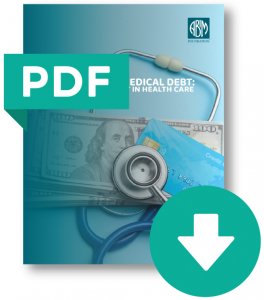- Medical Professionalism
- The Physician Charter
- Building Trust
- Health Equity & Inclusion
- Choosing Wisely®
- Grants
- ABIM Foundation Forum
- 2024 Being a Trustworthy Professional in an Untrusting World
- 2025 Reimagining Professionalism: Hope in a Shifting Medical Landscape
- 2023 Reframing Trust – A Path to Address Misinformation
- 2022 Fact or Fiction – Strategies for the Misinformation Age
- 2021 Pursuing Trust – Striving for Equitable Health Care
- 2020 Building Trust & Health Equity
- 2019 [Re]Building Trust – A Path Forward
- 2018 [Re]Building Trust

Medical debt in the United States has become a pressing issue – it affects more than 100 million Americans, who owe nearly $220 billion, and severely diminishes both patients’ trust in the health care system and their ability to access care. Many patients face financial burdens due to the increasing costs of care, inadequate insurance coverage, and unexpected medical emergencies. The 2022 KFF Health Care Debt Survey found that one in five adults in the United States reported having problems paying medical bills, and among those, 63 percent reported using all or most of their savings to pay these bills. Additionally, the Consumer Financial Protection Bureau reported that medical bills are the most common reason for individuals to be contacted by collection agencies.
A wide variety of attributes of our health care system contribute to the problem of debt, from the prices of health care products and services to changes in insurance policies to the billing practices of health systems and hospitals. Although there are many causes, their clear effect is to reduce trust in the health care system: only 15 percent of Americans with health care debt report that they trust that their providers have patients’ best interests in mind.
In June 2024, more than 60 health care leaders and advocates met to discuss best practices and promising approaches to address medical debt in the United States

Establish/expand financial aid programs:
- Adopt a presumptive eligibility policy to qualify patients for immediate financial assistance automatically based on their income, their use of other means-tested programs (such as food stamps) or other characteristics.
- Expand financial assistance (charity care) to more patients (i.e. lower income threshold or %FPL) and make financial assistance applications simpler and less invasive. For example, don’t require details on patients’ assets, pay stubs, tax returns, or other personal information that people are reluctant to share.
- Increase the number of financial counselors and patient advocates, support their retention, involve them in QI projects, and communicate with patients about their availability.
- Collaborate with providers to encourage enrollment in financial assistance and encourage ordering financial counseling for inpatients before discharge.
Improve billing:
- Prohibit inequitable, extraordinary collection actions such as reporting patients to credit reporting companies and taking legal action against patients (including liens and wage garnishment).
- Improve clarity, simplicity, and accuracy of patient billing and set limits for what patients can be billed.
- Adopt a policy not to deny care based on previous unpaid bills and prohibit sending bills to those being assessed for Medicaid.
- Support the extended care team to get involved, offer billing training for all employees and ensure processes to correct billing mistakes.
Work on systems changes:
- Ensure that HDHPs offered to own employees include essential covered items; limit out of pocket premiums.
- Commit to price transparency with reliable price estimates for scheduled services.
- Create a system to report and investigate any time that medical debt occurs to learn the cause and use continuous process improvement to avoid it in the future.
- Make it clear to patients the organization is committed to billing ethically so they are not deterred from seeking needed care.
Actions requiring coordinating efforts:
- Advocate for Medicaid expansion and elimination or stricter regulation of high-deductible health plans.
- Create a national pledge or campaign for hospitals who bill ethically.
- Measure and report medical debt data to a health system’s C-Suite and Board of Directors, including debt’s impact on the system’s workforce.
Potential areas of research needed:
- Understanding if training all hospital staff members about their institution’s financial assistance policies reduces debt burden.
- Measuring the administrative burden and cost to hospitals of collecting medical debt and the return they receive on that investment (i.e., Does collecting debt actually improve hospitals’ profitability? Would advertising a hospital as “billing ethically” change patient behavior and impact the hospital’s bottom line?).
- Understanding the impact on debt burden of simplifying health systems’ financial assistance policies, such as through the adoption of presumptive eligibility.
- Quantifying the effect that medical debt—and the fear of incurring it—has on health outcomes (e.g., through the avoidance of care).
- Creating a model legal or regulatory framework for ending debt that hospitals can adopt/adapt.


